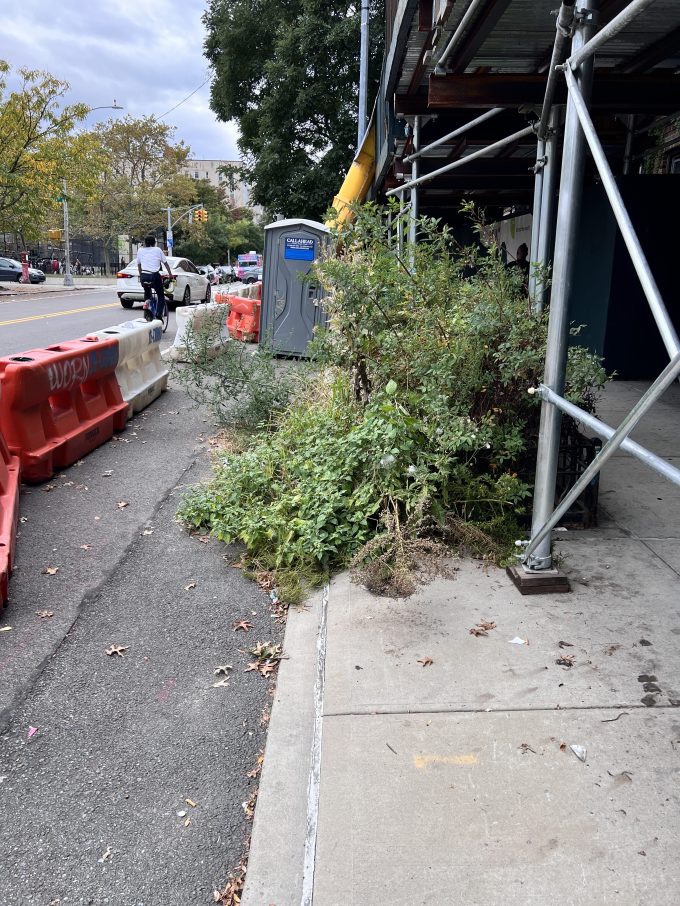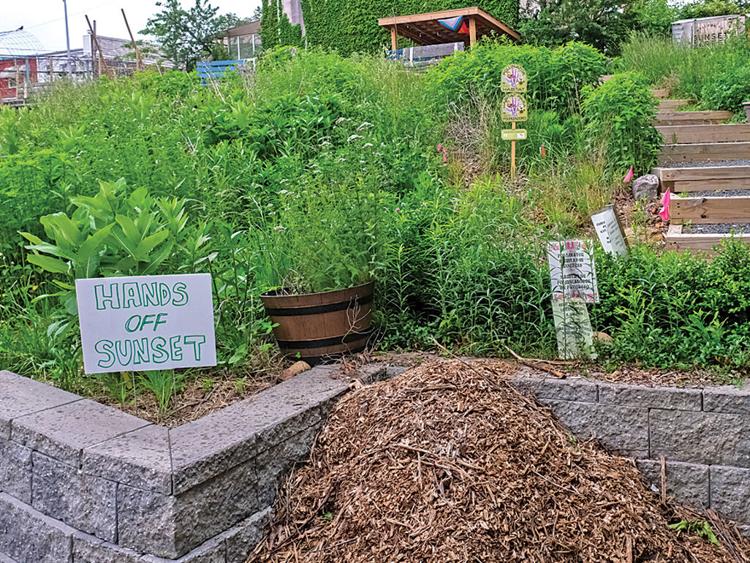It seems to be falling on deaf ears, no matter who you complain to. Nothing is being done.
Thursday, June 26, 2025
Rogue parking company reimagines and colonizes the curbs
Wednesday, June 25, 2025
Socialist beats sociopath to win NYC mayoral democrat primary
Dark-horse socialist candidate Zohran Mamdani staged a stunning upset Tuesday night by knocking off former Gov. Andrew Cuomo in the Democratic mayoral primary.
“Tonight we made history,” Mamdani told supporters at his victory party after midnight. “In the words of Nelson Mandela, ‘It always seems impossible until it is done.’ My friends, we have done it. I will be your Democratic nominee for the mayor of New York City.”
The 33-year-old Queens assemblyman defied polls and expectations as he notched a likely insurmountable 7-point lead over Cuomo, the three-term governor who hoped to make a political comeback after resigning in disgrace in 2021.
“Tonight is his night. He deserved it, he won,” a seemingly shell-shocked Cuomo, 67, said as he conceded to Mamdani.
The first round of the ranked-choice voting contest had Mamdani ahead with 43.51% of votes, followed by Cuomo’s 36.42% and city Comptroller Brad Lander’s 11.31%, Board of Elections unofficial results show. Mamdani carried roughly 432,000 votes to Cuomo’s 362,000, the results show.
The state lawmaker didn’t crack 50% of votes, so the contest will still be decided July 1 once the other rounds of ranked-choice votes are calculated.
But the first-round totals still put the avowed democratic socialist within sight of becoming New York City’s next mayor.
Cuomo conceded he lost the primary as he addressed his campaign’s watch party — and signaled he may not run in the November general election on an independent line, as widely assumed.
“Tonight was not our night,” Cuomo said, as he praised Mamdani’s grassroots campaign, which mobilized young, far-left voters with catchy campaign promises and slogans focusing on affordability.
“It’s affordability, stupid,” quipped longtime New York City political operative Kevin McCabe, in a reference to Bill Clinton, about the issue that decided the race.
A win by Mamdani is bound to have sweeping impacts beyond the Big Apple and signal the rising power of the Democrats’ progressive wing, especially over aging party stalwarts such as Cuomo.
His near-insurmountable lead hints he could be replicating what his backer and fellow progressive Rep. Alexandria Ocasio-Cortez did in 2018, as she ran as a charismatic outsider to topple entrenched Democrat Joe Crowley — only he did it across the whole city, a political veteran told The Post.
Cuomo could barely be seen actually on the campaign trail as he relied on his name recognition, backing of powerful unions and attacks against Mamdani’s thin legislative record and ample history of criticizing Israel.
The scandal-scarred ex-governor entered the race in March as the clear frontrunner, but saw his polling lead steadily chipped away by Mamdani, who waged a social media-friendly campaign heavy on proposed freebies — which he plans to pay for by hiking taxes on billionaires and businesses.
“He should’ve learned a lesson from the terrible, Rose Garden race that Joe Crowley ran against AOC. Like Crowley, Cuomo was arrogant and grossly underestimated his opponent,” said Democratic operative Ken Frydman.
A year after the slumlord fire, tenants and the building they once called home are still suffering

Eighteen months after a five-alarm fire gutted a Queens apartment building, dozens of displaced tenants remain locked out of their homes — and now, state lawmakers are proposing legislation to hold landlords accountable for prolonged repair delays across New York City.
The fire ignited just before noon on Dec. 20, 2023, at 43-09 47th Ave. in Sunnyside, as residents prepared for the holiday season. Investigators determined the blaze was caused by a contractor hired by building owner A&E Real Estate. The contractor was illegally using a blowtorch during construction work.
What unfolded in Sunnyside has become a symbol of a broader crisis. Across the five boroughs, tenants displaced by fires often wait months — or even years — to return home, as landlords delay essential repairs and face few consequences. The Sunnyside case has galvanized lawmakers to push for stricter enforcement and firm deadlines to accelerate recovery and protect tenants left in housing limbo.
For Koenig, reentering the housing market after more than a decade in a regulated apartment has been financially and emotionally overwhelming.
“It was a perfect storm,” she said. “You’ve got the holidays, housing crisis, inflation.”
In the aftermath of the fire, A&E Real Estate offered displaced tenants six-month temporary relocation license agreements, allowing them to rent units in other A&E-owned buildings at the same rate they had paid in Sunnyside. Under mounting pressure from elected officials and community members, the company later extended the agreements twice — each time for an additional six months.
But tenant Lauren Koenig said most residents turned down the offers, noting that the available apartments were located far from their Sunnyside neighborhood — in the Bronx or deep into Queens — effectively uprooting them from the community they had long called home.
“Only about 25 people took the deal, because it’s a raw deal,” Koenig said. “I didn’t take it.”
Koenig said tenants had repeatedly asked A&E to offer alternate housing in its other Sunnyside properties, but the company was not responsive. As a result, she spent nearly a year without stable housing, relying on the generosity of friends and moving between apartments as she searched for something suitable in the area.
“I don’t have kids — I only have to take care of myself,” she said. “I can’t imagine the pain of trying to do this while caring for an elderly parent, or with a newborn, young children, or pets. I cannot imagine what others went through.”
Koenig eventually secured an apartment nearby, but it came at a steep cost: $3,100 per month — $500 more than her previous rent-stabilized unit — amounting to a $6,000 annual increase.
In response, an A&E spokesperson said the company had only a limited number of vacant units in Sunnyside and insisted it “did its best” to keep displaced residents in the neighborhood. While acknowledging the hardship tenants faced, the spokesperson called the situation “imperfect” and maintained that the company’s options were limited.
Melissa Orlando, a market-rate tenant who was displaced by the fire, said she immediately found another apartment in the area because she had a young son and didn’t want to “bounce around” from place to place. Furthermore, she was going from one market rate unit to another, so the price difference wasn’t vast. However, many tenants with rent stabilized and rent controlled units could not afford comparable apartments at the new price.
“Fortunately, I had the means to go and find a new place to live, but the rent-stabilized and rent-controlled tenants in that building are here, there and everywhere, scattered, all over the city,” Orlando said. “A lot of them have been in that building for very long time… and if you’re in something that was stabilized or rent-controlled and now to have to go out into the market, that’s a serious shock.”
On the day of the fire, Orlando heard sirens but smelled no smoke. She left her apartment only after checking the Citizen app, grabbing whatever essentials she could. At the time, she assumed she would be able to return home later that evening.
In the shock of watching the fire rip through the building, Orlando admitted thinking that she might be able to re-enter her apartment that evening.
In the days immediately following the fire, Orlando said A&E appeared responsive, setting up a temporary office across the street, distributing holiday gifts and meals to impacted families. But that initial cooperation quickly faded. After Christmas, Orlando said, A&E’s tone shifted — and interactions with tenants became increasingly tense.
“Every step of the way it’s been a fight with them,” she said.
Orlando also said the alternative accommodation offered by A&E was in “far-flung places” where she didn’t feel safe walking at night.
Nearly 18 months later, no repair work has begun on the building, despite repeated calls from tenants, elected officials, and city agencies. The city’s Department of Housing Preservation and Development is now suing A&E to compel them to begin restoration.
NYC Council Member Julie Won has penned an open letter criticizing the owners of a Sunnyside apartment complex damaged by a five-alarm fire last December for allowing the area surrounding the site to become a “dumping ground” over the past several months.
Won addressed the letter to A&E Real Estate, the landlord of an apartment building at 43-09 47th Ave., severely damaged by fire on Dec. 20 last year.
She accused A&E of allowing litter, trash and human waste to build up around the perimeter of the building over the last few months, writing that she has personally seen Sunnyside residents wading through bottles filled with urine, bags filled with waste and other forms of trash.
Won described the situation as “an egregious health hazard and profoundly unsanitary” and added that the problem partly stems from security workers at the building having no access to port-a-potties or trash cans.
She cited NYC Admin. Code 16-118, which states that property owners and landlords are required to keep public areas near a building in a clean and sanitary condition, including sidewalks and the first 18 inches of road by the sidewalk.
“A&E has not adhered to this law, instead allowing the sidewalk under the scaffolding to go into disrepair and allow litter to accumulate even on the road outside the building,” Won said in the letter. “This presents unsanitary conditions and a possible fire hazard.”
A spokesperson for Won said the issue dates back to at least the start of the summer, stating that the Council Member has regularly sent Department of Sanitation and ACE cleaning teams to clean up the area.
However, the spokesperson said the current state of the building is encouraging people to dump trash and garbage underneath the scaffolding, meaning that the area quickly becomes litter-strewn after each cleaning.
Won has urged A&E to dedicate time and resources to keeping the public-facing areas of the building clean and free of litter, while she has also asked the real estate company to provide overnight port-a-potty access to security workers on a daily basis.
Won has requested a response from A&E by Oct. 15.
Friday, June 13, 2025
Candidate busted ripping down and discarding opponent's legally posted campaign material
This dude also has been sucking up to a TransAlt group that wants to take the B13 away from Glendale, so watch out, District 30!
Not a surprise then that Bob Holden endorsed Phil Wong.
Tuesday, June 10, 2025
Thursday, June 5, 2025
The fugliest apartment building in the City Of Yes.
I like to call this the Felix The Cat building, because it looks like his magic bag of tricks made it.
Police got their back

It took four decades, but residents of Southeast Queens and the elected officials who represent them say their neighborhoods are finally getting the policing they deserve.
NYPD officials and elected officials said last week that since the new 116th Precinct finally opened in December to police the neighborhoods of Springfield Gardens, Brookville, Laurelton, and Rosedale, response times in adjacent precincts are down and the new cops are beginning to address long-time local complaints.
Speaking before the City Council on Thursday, Police Commissioner Jessica Tisch said that response times in the two precincts that used to split the area now covered by the 116th are significantly down.
“We have seen great results, I would say, in terms of the decrease in response times since that command opened up,” Tisch said. “We are pleased with what we are seeing in terms of the trends in response times.”
In the 105th Precinct, response times have been cut by more than half. Before the 116th opened, 105th Precinct cops took an average of 21 minutes and three seconds to respond. Now, it takes them, on average, eight minutes and 38 seconds.
Response times for the 113th Precinct have also decreased by a little over four minutes, down from 20 minutes and 48 seconds to 16 minutes and 19 seconds on average.
The new precinct is staffed by 199 people, including two captains, seven lieutenants, 20 sergeants, 147 police officers and detectives and 23 civilians.
The Eagle reached out to the NYPD for response times for 116th Precinct and whether or not those staffing levels are expected to grow. The NYPD’s press office referred the Eagle back to Tisch’s Thursday comments, which did not answer the questions.
Tisch on Thursday was asked about the 116th during a City Council budget hearing by the local councilmember, Selvana Brooks-Powers, who is happy with the results the precinct has brought so far.
“Response times [being] down is something that's significant,” she told the Eagle. “That's an area that the community, for many years, complained about. At times, there were people who would call my office and feel like calling the precinct was a waste of time because of how long it would take. I don't hear those complaints right now…the data around it supports what we're feeling on the ground.”
Before the 116th opened, the 105th and 113th split the large chunk of Southeast Queens, meaning cops were travelling large distances to respond to calls.
“If there was a big situation happening in the southern part of the community, they would have to get there from the far end of their confines,” Brooks-Powers said. “But right now, this is a precinct that's within our community, so naturally they're going to be able to respond much more quickly.”
Brooks-Powers said she is happy with the community and policing efforts from the new precinct, as well as the management of the station from its inaugural commanding officer, Jean Beauvoir.
“They've been also taking steps to be more community oriented,” she said. “I've seen firsthand the work that they've done to really combat a lot of the double parking that we experience along the Merritt Boulevard corridor, in particular.”
Radical group gets to discriminate at a community garden for a month longer.

Shortly after the city Parks Department moved to evict Ridgewood’s Sunset Community Garden, it said it will stick around.
The group behind the garden at Onderdonk and Willoughby avenues said Wednesday that the New York County Supreme Court has granted a temporary restraining order against Parks and GreenThumb, the agency’s program that supports hundreds of gardens in the city.
Parks had issued a termination notice last month after it found the group out of compliance with community garden rules for requiring new members to affirm its political and ideological views. Those who wish to join the garden are required to uphold a set of “community values” that includes rejections of Zionism, homophobia, transphobia, racism and sexism.
The agency said it had been working with the group since last September to address violations.
Members say the city also tried to remove a memorial honoring transgender activist Cecilia Gentili, for whom the garden has been renamed Jardin de Santa Cecilia. Parks said the altar did not qualify for permanent installation and that, although it had suggested ways to keep it on display, the group refused.
“As Pride begins, this victory makes clear: Our lives, art, and voices are not violations. They are human rights,” group leaders said in a press release. “Pride is a riot they can’t silence, and this garden is a home they can’t take away from us.”
A Parks spokesperson said the agency was notified Tuesday that a garden member had filed an order to show cause for a TRO to enjoin Parks from ending the garden’s license agreement. The TRO was signed the next day and will remain in effect until July 17, when the court is set to hear arguments from both sides regarding next steps, the agency said.
According to the group, the court determined there was a “likelihood of success” on the merits of its allegations of violations of the city’s Human Rights Law and the First Amendment. It said in the release that the city falsely labeled its community values discriminatory and demanded that its license be reinstated and the altar recognized as protected speech.
“This ruling is a lifeline for our community,” garden leaders said.
Funny thing about this is that the Parks Dept tried to negotiate with them for their alter for an activist who never lived in the area and they refused to cooperate and how they are such freedom fighters they think it's right for people to sign a pledge in fealty to their beliefs to help maintain the garden. That's not how community gardens or how this country works.
















